Boeing 777 family of airplanes are the most technologically advanced airplanes in the world. 777s seat from 301 up to 368 passengers in a three-class configuration with a range of 5,210 nautical miles (9,649 km) in 777-200 to 8,810 nautical miles (16,316 km) for 777-200LR (longer range). 777 -- the world's largest twinjet -- is available in five models: the 777-200, a 777-200ER (extended range), a larger 777-300 as well as two new longer-range models, 777-200LR and 777-300ER, which are both in development.
United Airlines, All Nippon Airways, British Airways, Japan Airlines and Cathay Pacific were among a number of carriers with whom Boeing held intensive discussions, including many team sessions, to define and develop the new airplane's configuration. Participating airlines represented a full range of operations with varying route structures, traffic loads and service frequency. Their input to the design process helped ensure the final product has the broadest possible application to the needs of the world's airlines.

Because 777 design responds to market needs and customer preferences, the result is an airplane offering cabin spaciousness and flexibility found in no other jetliner along with many features to enhance reliability and productivity -- all with lower operating costs. 777 provides the most payload and range capability and growth potential in medium-sized airplane category. Another benefit of intensive customer dialogue was a consensus that many items traditionally offered as optional, or unique features on other airplanes should be standard (or basic) equipment on 777 since they are so frequently specified by most airlines. About 80 such items -- including satellite communication and global positioning systems -- are basic to the airplane. This reduces variability during design and production, while providing the airlines with a more economical equipment package.
777 wing is the most aerodynamically efficient airfoil ever developed for subsonic commercial aviation. In a further refinement of designs introduced on Boeing 757 and 767, 777 wing features a long span with increased thickness. This advanced wing enhances the airplane's ability to achieve higher cruise speeds, climb quickly and cruise at higher altitudes than competing airplanes. It also allows the airplane to carry full passenger payloads out of many high-elevation, high-temperature airfields.
Fuel volume requirements for 777 are accommodated entirely within the wing and its structural center section. Fuel capacity ranges from 31,000 gallons (117,335 L) for 777-200 to 51,590 (195,285 L) for 777-200LR.
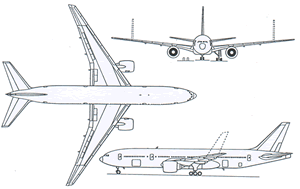
Boeing 777-200 twin-turbofan high capacity airliner
Airlines helping to design 777 encouraged Boeing to commit to the performance capabilities of an optimum wing, which has a span of 199 feet 11 inches (60.9 m).
Raked 6.5-foot wingtips are being added to 777-200LR and 777-300ER to improve the overall aerodynamic efficiency of the wing. The raked wingtip helps reduce takeoff field length, increase climb performance and reduce fuel burn.
Three engine manufacturers developed more efficient and quieter turbofans to power 777, and all three have been selected by 777 customers. Engine selection for 777 is split at roughly one-third for each of the engine manufacturers. Pratt & Whitney offers the PW4000 series of engines, General Electric offers its GE90 series, and Rolls-Royce offers Trent 800 series of engines.
All three engines offer excellent fuel efficiency, while allowing 777 to be as quiet as a 767, even though 777 engines provide 40 percent more power. Key factors in this performance are new, larger-diameter fans with wide-chord fan blade designs and bypass ratios ranging from six-to-one to as high as nine-to-one. This compares to the typical five-to-one ratio for the engines of previous twin-aisle jets.
New, lightweight, cost-effective structural materials are used in several 777 applications. For example, an improved aluminum alloy is used in upper wing skin and stringers. Known as 7055, this alloy offers greater compression strength than current alloys, enabling designers to save weight and also improve corrosion and fatigue resistance.
Progress in the development and fabrication of weight-saving advanced composite materials is evident in 777. Carbon fibers embedded in recently available toughened resins are found in vertical and horizontal tails. Floor beams of the passenger cabin also are made of these advanced composite materials.
Other composite applications include those on secondary structures such as aerodynamic fairings. Composites, including resins and adhesives, account for 9 percent of 777's structural weight, compared to about 3 percent on other Boeing jets.
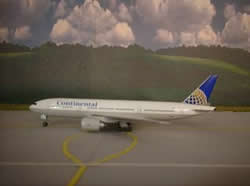
In response to airline preference, the layout of 777 flight deck is in a horizontal format similar to that of 747-400. Principal flight, navigation and engine information is presented on six large display screens.
Although these displays resemble conventional cathode ray tube (CRT) screens, they incorporate advanced liquid-crystal display technology. The depth of the new "flat panel displays" are about half that of CRTs. In addition to saving space, the new displays weigh less and require less power. They also generate less heat, which contributes to greater reliability and a longer service life. As another benefit, the displays do not require the heavy, complex air conditioning apparatus needed to cool equipment on current flight decks. Pilots appreciate that flat panel displays remain clearly visible in all conditions, even direct sunlight.
Three multipurpose control display units (CDU), installed in the center aisle stand, provide data display and entry capabilities for flight management functions. These units are the primary interface with an integrated Airplane Information Management System (AIMS). The CDUs have color displays, again in response to market preferences. Adding color allows pilots to assimilate the information more quickly.
AIMS provides flight and maintenance crews all pertinent information concerning the overall condition of the airplane, its maintenance requirements and its key operating functions, including flight, thrust and communications management.
The flight crew transmits control and maneuvering commands through electrical wires, augmented by computers, directly to hydraulic actuators for the elevators, rudder, ailerons and other control surfaces. This three-axis "fly-by-wire" flight control system saves weight, simplifies factory assembly compared to conventional mechanical systems relying on steel cables, and requires fewer spares and less maintenance in airline service.
A key part of 777 systems is a Boeing-patented two-way digital data bus, which has been

adopted as a new industry standard: ARINC 629. It permits airplane systems and associated computers to communicate with one another through a common wire path (a twisted pair of wires) instead of through separate one-way wire connections. This further simplifies assembly and saves weight, while increasing reliability through a reduction in the amount of wires and connectors. There are 11 of these ARINC 629 pathways in the 777.
777 was the first Boeing model to be equipped with the Enhanced Ground Proximity Warning System (EGPWS) as standard equipment. The EGPWS displays potentially threatening terrain and gives an audible alert up to a minute in advance of possible terrain conflict, compared with 10 to 15 seconds for previous systems. It incorporates a proprietary digital terrain map, which it continuously compares to aircraft position data from the navigation system.
One new feature in 777-300 flight deck is the addition of a Ground Maneuver Camera System (GMCS), designed to assist the pilot in ground maneuvering of 777-300 with camera views of the nose gear and main gear areas. Cameras are on the leading edge of the left and right horizontal stabilizers and the underside of the fuselage and are used during ground maneuvering. Images are displayed at the Multi-Functional Display positions in the flight deck in a three-way split format.
In 1993, 777 flight deck received accolades from the Industrial Designers Society of America. For the second year in a row, 777 received the society's Industrial Design Excellence Award for its flight deck design.
In addition to being one of the most spacious passenger cabins ever developed, 777 interior offers operators unsurpassed configuration flexibility. Flexibility zones have been designed into the cabin areas specified by the airlines, primarily at the airplane's doors. In one-inch increments, galleys and lavatories can be positioned anywhere within these zones, which are pre-engineered to accommodate wiring, plumbing and attachment fixtures. Passenger service units and overhead stowage compartments are designed for quick removal without disturbing ceiling panels, air conditioning ducts or support structure. A typical 777 configuration change is expected to take as little as 72 hours, while such a change might take two to three weeks on existing airplanes.
Large overhead compartments provide passengers with increased stowage capacity. Outboard as well as center stowage units are designed to open downward for convenient loading. When closed, they fit neatly into the streamlined contours of the interior architecture and allow ample overhead clearance.
For improved, more efficient in-flight service, 777 is equipped with an advanced cabin management system. Linked to a computerized control console, the cabin management system assists cabin crews with many tasks and allows airlines to provide new services for passengers, including a digital sound system comparable to the most state-of-the-art home stereo or disc players.
A 1992 Industrial Design Excellence Award was awarded to the passenger cabin of the new Boeing 777 jetliner, the first time the Industrial Designers Society of America honored an airplane interior.
A survey of thousands of passengers flying long-range routes around the world in first, business and economy classes revealed an overwhelming preference for 777. The survey, conducted in 1999 and 2000 around the world, found that the Boeing 777 was preferred by more than three out of four passengers worldwide who had flown aboard both 777 and Airbus A330/340 airplanes.
777 and 767-400ER share the same wheels, tires and brakes. Longer-range 777s share a new and improved gear. 777-300ER, because of its longer length, uses a new semi-levered gear, which allows it to take off from limited fields.
New design and testing initiatives helped ensure the highest possible levels of reliability on the very first 777, compared to what had been possible on previous jetliner introductions. Today's 777 operators enjoy a 99 percent dispatch reliability rate, which is unmatched in the industry.
Design/build teams, which bring together representatives of the diverse disciplines involved in airplane development, as well as suppliers and representatives of airline customers, allowed team members to work concurrently on 777 structural and systems designs.
Continuing the "market-driven" approach, four 777 customers had on-site representatives working side by side with Boeing designers to ensure that the new airplane filled their needs. United Airlines, All Nippon Airways, British Airways, and Japan Airlines had teams of two to four engineers onsite who were actively involved in developing 777.
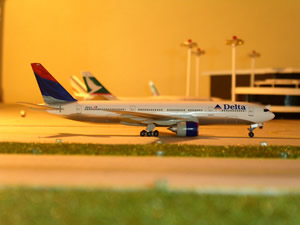
For the first time, digital computers were used by Boeing engineers to design and electronically pre-assemble the entire airplane, increasing accuracy and improving quality. New laboratory facilities enabled the various airplane systems to be tested together as a single integrated entity in simulated flight conditions - before the first jetliner took to the air. This allowed a smoother transition to flight testing and service introduction.
Among other initiatives, standard certification flight tests were supplemented with 1,000 flight cycles on each airframe/engine combination for the initial 777-200 model to demonstrate reliability in simulated airline operating environments. Boeing/United Airlines 1,000-cycle flight tests for the Pratt & Whitney engine were completed on May 22, 1995. In addition, engine makers and many parts suppliers for the airplane intensified their own development and testing efforts to ensure that their products met airline requirements.
On May 30, 1995, 777 became the first airplane in aviation history to earn U.S. Federal Aviation Administration (FAA) approval to fly 180-minute extended range twin-engine operations (ETOPS) at service entry. On May 4, 1998, 777-300 achieved another historic milestone by becoming the first commercial airplane to receive type certification and 180-minute ETOPS approval on the same day.
Skills and resources of a number of international aerospace companies contribute to the design and production of 777. Firms in Europe, Canada, Russia, Asia/Pacific and the United States provide components and portions of the structure to Boeing.
Llargest single overseas participant is the Japanese aerospace industry. Led by Mitsubishi Heavy Industries, Kawasaki Heavy Industries and Fuji Heavy Industries, this group of companies is continuing its long-standing business relationship with Boeing. Together, these firms helped design and build about 20 percent of the airframe structure.
|
777-200 |
777-200ER |
777-200LR
|
Boeing 777-300 |
777-300ER |
|
|
|
|
|
|
|
|
|
|
|
|
|
|
|
|
|
|
|
|
|
|
|
|
|
|
|
|
|
|
|
|
|
|
|
|
|
|
|
|
|
|
|
|
|
|
|
|
|
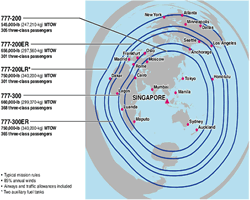 |
 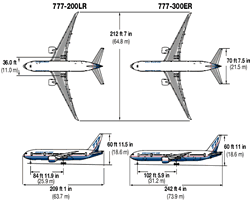 |
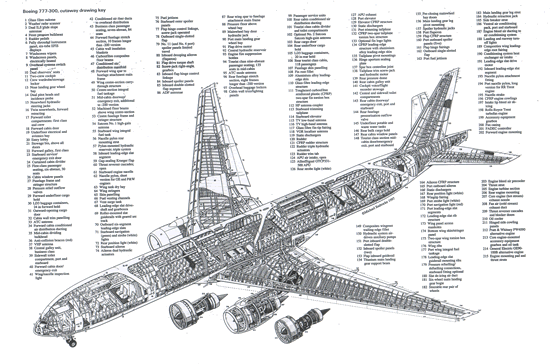
Boeing 777-300 is a high-capacity, stretched version of the 777-200 twinjet. This newest member of the 777 family of jetliners is "market-driven" to meet airline demand for a jetliner sized to replace older twin-aisle airplanes, including early versions of 747.
777-300 complements 777-200 models by providing greater capacity and lower costs per seat within 777 family.
Boeing board of directors authorized production of 777-300 on June 26, 1995. Boeing had been studying the market feasibility of "stretching" the popular 777-200 for some time, involving more than a dozen airlines in "Working Groups" to establish customer requirements and firm up aspects of the design for the proposed airplane. In this way, the market-driven approach that led to 777-200's launch in 1990 continued to shape 777 family with the stretched 777-300.
The formal authorization, or "go-ahead," for the program followed announcements at the 1995 Paris Air Show that four airlines (All Nippon Airways, Cathay Pacific Airways, Korean Air and Thai Airways International) intended to order 31 of the long-range twinjets valued at approximately $3.1 billion, depending on configurations, special features and options selected.
With delivery of the first 777-300 in May 1998, to Cathay Pacific Airways of Hong Kong, 777 family of airplanes provides the unparalleled level of flexibility, economy and capability originally envisioned with the launch of the program in 1990.
777-300 offers all the new features of passenger comfort found in 777-200 - including cabin spaciousness and flexibility.
777-200LR (longer range) and 777-300ER (extended range) airplanes are two longer-range airplanes that Boeing is developing. Launched in February 2000, the two airplanes will fly farther and faster than the A340 competition, which offers airlines additional flexibility in serving the non-stop routes that passengers demand.
Design work on both of the new longer-range airplanes is under way. Rollout of the first of the two models, 777-300ER is slated for late 2002. Flight testing of 777-300ER will take place in 2003. Rollout of the second of the two longer-range airplanes is slated for 2004.
Boeing anticipates a market demand for more than 500 of these two new 777 models, with about 45 percent of those airplanes going to Asian operators.
All 777 models have the most spacious passenger cabin ever developed. In fact, during a recent worldwide survey, conducted by numerous airlines and including nearly 6,000 passengers who had flown on both 777 and A330 and A340, travelers said they overwhelmingly preferred 777. More than three out of four passengers said they prefer to fly on a 777.
A 1992 Industrial Design Excellence award was presented to Boeing for its 777 passenger cabin. This is the first time the Industrial Designers Society of America honored an airplane interior.
777's award-winning interior has large overhead compartments that provide passengers with increased stowage capacity. Outboard as well as center stowage units are designed to open downward for convenient loading. When closed, the stowage units fit neatly into the streamlined contours of the interior architecture to allow ample overhead clearance. A six-foot-two inch (188 cm) passenger can pass easily under the center bins.
Like other members of the 777 family, both 777-200LR and 777-300ER offer the widest seats in all

classes when compared to A340. First-class passengers on all 777 models have 21-inch (53 cm) wide seats, which allow passengers to enjoy the same level of comfort as on the 747. Business-class seats are 20 inches (50 cm) wide - same width as A340's first-class seats. In economy class, 18.5-inch (47 cm) wide seats -- widest in the industry -- are standard compared to 17.2-inch (44 cm) wide seats on A340.
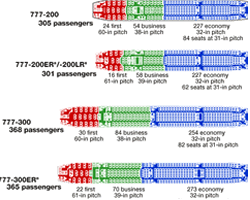 Typical Boeing 777-200 and Boeing 777-300 seating option |
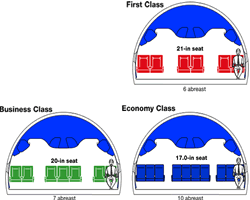 |
Approximately 35 percent of the longer-range 777's design will be changed from earlier 777 models, although passengers won't notice it. Each wing is being extended by 6.5 feet, and raked wingtips are being added to improve overall aerodynamic efficiency. Raked wingtips help reduce takeoff field length, increase climb performance and reduce fuel burn.
Provisions for up to three optional fuel tanks also are being added in the aft cargo compartment for 777-200LR, to allow for its range of 8,820 nautical miles (16,316 km), the longest range commercial airplane. The body, wing, empennage and nose gear of the airplanes are being strengthened and new main landing gear, wheels, tires and brakes will be installed. The struts and nacelles are being modified to accommodate the significantly higher-thrust engines.
A supplementary electronic tailskid will be standard on both models. This software feature helps prevent inadvertent scraping of the tail on the runway at take off or landing by commanding elevator movement if the airplane's attitude exceeds pre-set limits.
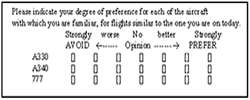 |
Both longer-range 777s offer the option of overhead crew and attendant rest areas. By moving crew and attendant quarters off the main deck, airlines can free as many as five-to-seven revenue seats, which can then be used for passengers.
Using overhead space for crew rest areas also frees up room for an additional four-to-six LD-3 containers in the cargo hold. Crew rests are traditionally located in the cargo compartment. This revenue-generating capability is another innovation the competitor's airplane (A340 family) cannot match because of A340's constrained cross-section design. These LD-3s can be used for additional cargo, an option that is unavailable on any Airbus model.
Through innovative applications of computing technology, 777 program exceeded its goal of reducing change, error and rework by 50 percent. Parts and systems have fit together better than anticipated and at the highest level of quality. The first 777 was just .023 of an inch -- about the thickness of a playing card -- within perfect alignment while most airplane parts line up to within a half inch to each other.
In the mid-1980s, The Boeing Company invested in three-dimensional CAD/CAM (computer-aided design/computer-aided manufacturing) technology for strategic reasons. By the end of that decade, a single strategy for applying this capability emerged after numerous pilot programs were conducted.
The pilot programs clearly demonstrated the benefits of modeling airplane parts as three-dimensional solids in the CATIA (computer-aided three-dimensional interactive application) system. Developed by Dassault Systemes of France and marketed by IBM in the United States, CATIA, along
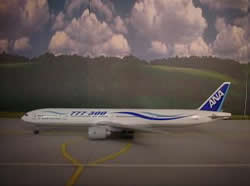
with several Boeing-created applications - allowed Boeing engineers to simulate the geometry of an airplane design on the computer without the costly and time-consuming investment of using physical mock-ups.
Studies at Boeing show that part interference (incidents of assembly parts overlapping each other) and difficulty in properly fitting parts together in aircraft final assembly are the most pervasive problems in manufacturing airplanes.By 1989, the Boeing Engineering organization was confident that it could significantly reduce the costly rework caused by part interference and fit problems by digitally pre-assembling the airplane on the computer.
The improved accuracy in part design and assembly, as well as the instantaneous communication capability of this technology convinced Boeing that the significant investment required to implement it would more than pay for itself in the long run by improving the quality of airplane designs and reducing the cycle time required to introduce new airplanes into the marketplace.
The opportunity to apply the new CAD/CAM approach as well as other new engineering and manufacturing ideas came in 1990 with the launch of the Boeing 777 twinjet. 777 program established design/build teams to develop each element of the airplane's airframe or system. Under this approach, all of the different specialties involved in airplane development -- designers, manufacturing representatives, tooling, engineers, finance, suppliers, customers and others -- worked jointly to create the airplane's parts and systems. Based at the same location, team members worked concurrently, sharing their knowledge rather than applying their skills sequentially.
Communication among the program's 238 design/build teams was accomplished by using sophisticated computers linked by the largest mainframe installation of its kind in the world, consisting of eight IBM mainframe computers. This computer network consisted of mainframes and work station installations in the Puget Sound area, Japan; Wichita, Kan.; Philadelphia; and other locations.
Central to the digital design approach was the CATIA system. From the beginning of 777 program, the three key participants in the system -- Boeing, Dassault Systemes and IBM -- developed a "working together" agreement signed by their respective chief executive officers. The three companies made a commitment in the agreement to deliver products and services on schedule to 777 program computer users.
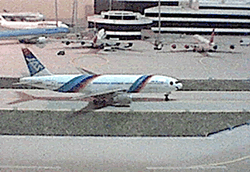
But the basic CAD/CAM technology provided by the CATIA system was not enough. The possibilities this technology provided required Boeing to rethink the entire process of designing and building an airplane in order to leverage these capabilities to their maximum extent. The company found that several enhancements to the CATIA system were required to allow engineers to productively design an entire airplane using these new processes. Boeing applications enhanced CATIA system in three major areas: data management, user productivity and visualization. Each of these major enhancements was required to deal with the size and scale of productively managing the millions of 777 airplane parts modeled on CATIA.
Once all of the computing applications were in place, Boeing engineers and designers were able to use the three-dimensional digital software to see parts as solid images and then simulate the assembly of those parts on the screen, easily correcting misalignments and other fit or interference problems.
In June 1995, Boeing 777 Division was recognized for its innovative application of computing technology to 777 when it won the top spot in the Manufacturing category of the annual Computerworld Smithsonian Awards. The awards honor the world's most creative and innovative use of information technology that benefit society. By earning top honors in the category, the Boeing Computing and Design Application earned a place in history in the Smithsonian Institution's permanent research collection. Information on the application also is available at The Information Age: People, Information & Technology, a permanent exhibit at the National Museum of American History, which has been viewed by millions of visitors.
|
1992 |
Interiors |
Passenger cabin of new Boeing 777 jetliner received the Industrial Design Excellence Award. This is the first time the Industrial Designers Society of America honored an airplane interior. |
|
1993 |
Flight Deck |
777 flight deck won the Industrial Design Excellence Award from the Industrial Designers Society of America. |
|
1995 |
Speed Records |
777 established National Aeronautic Association-certified speed records between Kiruna, Sweden, and Seattle; Bangkok and Seattle; Paris and Seattle; Frankfurt and Seattle; and Geneva and Seattle. 777 wing design allowed the airplane to climb quickly to initial cruise altitudes of up to 2,000 feet higher than comparable transports. |
|
1995 |
Certification |
Boeing 777-200 received type and production certification from the U.S. Federal Aviation Administration (FAA) and Europe's Joint Aviation Authorities (JAA) on the same day (April 19, 1995) an unprecedented achievement. 777 became the first airplane in aviation history to earn FAA approval to fly extended-range twin-engine operations (ETOPS) at service-entry. |
|
1995 |
Pilots |
Flight-test pilots Capts. John Cashman and Ken Higgins, the flight crew that piloted the Boeing 777 twinjet on its historic June 1994 first flight, were honored with separate aerospace industry awards for their contributions to aviation and flight testing. Cashman received the Society of Experimental Test Pilots' Iven C. Kincheloe Award, while Higgins received the National Aviation Club's "Cliff Henderson Award for Achievement." |
|
1995 |
Computing |
777 received a Smithsonian Computerworld Award for digital product definition and preassembly in manufacturing. |
|
1996 |
Industry Awards |
777 won the prestigious Robert J. Collier Trophy, awarded by the National Aeronautic Association. The award honored 777 as the top aeronautical achievement of 1995. Boeing was recognized specifically for "designing, manufacturing and placing into service the world's most technologically advanced airline transport." |
|
1996 |
Smithsonian Achievement Award |
777 received the 1996 Trophy for Current Achievement from the National Air & Space Museum Smithsonian Institution. The annual award recognizes outstanding achievements in the fields of aerospace science and technology. 777 Program was noted for being "a model of efficiency, utilizing the very latest technology, as well as developing a wide range of new technologies, to design, fabricate, flight test and finally to certify the aircraft for internation use." |
|
1997 |
Distance and Speed Records |
777-200ER (extended range), in Malaysia Airlines livery, established a new Great Circle Distance Without Landing record. The airplane flew from Boeing Field, Seattle, to Kuala Lumpur, Malaysia, covering 12,455.34 statute miles (20,044.20 km). The same airplane later went on to complete a record-setting circumnavigation of the world, establishing a new speed world record for its size and class of airplane. The Speed Around the World, Eastbound record was set by traveling the Seattle-Kuala Lumpur-Seattle route at an average speed of 553 miles per hour (889 km/h). |
|
1998 |
Certification |
777-300 earned type certification from the FAA and JAA and received FAA approval for 180-minutes ETOPS -- all on the same day. |
|
1999 |
Passenger Preference |
A survey of nearly 6,000 passengers flying on long-range routes to and from Europe in first, business and economy classes revealed an overwhelming preference for 777. The survey, conducted by six airlines based in Europe and the Middle East, found that the Boeing 777 was preferred by more than three out of four passengers who had flown aboard both 777 and Airbus A330/340 airplanes. |
|
23 JAN 2001 |
United Airlines, the airline that launched 777 Program, becomes first carrier to operate 50 777s. |
|
15 JAN 2001 |
Longer-Range 777-200 and 777-300 airplanes reach firm configuration |
|
31 DEC 2000 |
777 Program ends the year with a record number of sales in a one-year period. That year 117 777s were sold. |
|
14 NOV 2000 |
Boeing 777 powered by GE90-94B engines earns U.S. FAA certificate. |
|
09 NOV 2000 |
Popular Science magazine names 777-200 Longer Range airplane, with General Electric GE90-115 engines, to its Top 100 Best of What's New for 2000. |
|
31 OCT 2000 |
WA001, the first 777 built, rolls out the factory for a second time - this time as a Cathay-Pacific Airways airplane. |
|
19 OCT 2000 |
777 logs its 500th order - an American Airlines order for one 777-200ER. |
|
07 JUN 2000 |
Boeing 777 celebrates five years of world-class service. |
|
29 FEB 2000 |
The Boeing board of directors approves formal launch of the longer-range derivatives of 777, 777-200LR (longer range) and 777-300ER (extended range). |
|
6 JUL 2000 |
General Electric's GE90 derivative engine is selected as the sole power plant for the proposed longer-range derivatives of 777. |
|
17 JUN 1999 |
Boeing announces that it is proceeding with plans to study and possibly offer longer-range derivatives of 777. |
|
16 JUN 1999 |
A passenger preference survey shows that three out of four passengers who have flown on both Boeing 777 and Airbus A330/A340 airplanes prefer 777. |
|
04 AUG 1998 |
777 factory implements "three-day, one-bay" in which an airplane rolls out the factory every three manufacturing days, using one production line or bay. |
|
22 MAY 1998 |
First 777-300 is delivered to Cathay Pacific. The airline inaugurates its new airplane into service May 27, 1998, flying from Hong Kong to Taipei, Taiwan. |
|
12 MAY 1998 |
Japanese regulatory agency, Japanese Civil Aviation Bureau grants type certification to 777. |
|
04 MAY 1998 |
FAA and JAA grant type certification to 777-300. FAA also approves the airplane for 180-minutes ETOPS. |
|
09 APR 1998 |
Aviation Register, aviation regulatory agency for the Commonwealth of Independent States, grants type certification to 777. |
|
26 DEC 1997 |
777 Program makes its 100th delivery. The airplane goes to Saudi Arabian airlines |
|
16 OCT 1997 |
777-300 makes its first flight, starting a seven-month flight test program. The flight lasted four hours and six minutes. |
|
09 SEP 1997 |
The 100th 777 rolls out the factory. The airplane is delivered the following month to Thai Airways International. |
|
08 SEP 1997 |
Ceremonies mark the official rollout of first 777-300. |
|
15 SEP 1997 |
Major assembly begins on the 100th 777. |
|
07 APR 1997 |
Major assembly of first 777-300 begins |
|
02 APR 1997 |
Boeing 777-200ER sets a new Great Circle distance Without Landing record, flying 12,455.34 miles from Seattle to Kuala Lumpur, Malaysia. The airplane continues back to Seattle on its record-setting circumnavigation of the world at an average speed of 553 mph, setting a new speed world record for its size and class of airplane. |
|
17 MAR 1997 |
Fatigue tests on a test 777 airplane show that the airplane is capable of two times its minimum design service objective, simulating 60 years worth of service. |
|
07 MAR 1997 |
777 Program makes its 50th delivery. The airplane goes to United Airlines. |
|
06 FEB 1997 |
The first 777-200ER is delivered to British Airways. Three days later the airplane enters commercial service, flying from London to Boston |
|
15 NOV 1996 |
The National Air & Space Museum Smithsonian Institution presents the 777 development team with the 1996 Trophy for Current Achievement. |
|
06 NOV 1996 |
The 50th 777 rolls out the factory. The airplane is delivered the following month to All Nippon Airways. |
|
10 OCT 1996 |
FAA grants ETOPS approval to 777s powered by Rolls-Royce engines. |
|
07 OCT 1996 |
The first 777-200ER makes its first flight. |
|
03 OCT 1996 |
FAA grants ETOPS approval to GE-powered 777s. |
|
03 SEP 1996 |
Ceremonial rollout of the first 777-200ER. |
|
23 MAY 1996 |
777 Program makes its 25th delivery. The airplane goes to All Nippon Airways. |
|
13 MAY 1996 |
Major assembly begins on the 50th 777. |
|
20 FEB 1996 |
Major assembly of the 777-200ER (extended range) model begins. |
|
15 FEB 1996 |
The National Aeronautic Association announces that Boeing 777 is the winner of the prestigious Robert J. Collier Trophy for being the top aeronautical achievement of 1995. |
|
25 JAN 1996 |
The 25th 777 rolls out the factory. The airplane is delivered two months later to Thai Airways International. |
|
09 NOV 1995 |
The General Electric GE90/Boeing 777 engine/airframe combination is certified by the FAA, paving the way for delivery of the first 777 to British Airways two days later. |
|
26 JUN 1995 |
Frank Shrontz, chairman of the board and chief executive officer of The Boeing Company, announces that the board of directors has authorized production of a stretched version of 777 to be designated 777-300. |
|
14 JUN 1995 |
777 receives a Smithsonian Computerworld Award for digital product definition and preassembly in manufacturing. |
|
11 JUN 1995 |
777 establishes a new speed record on its flight from Seattle to the Paris Air show at Le Bourget. The flight of nine hours and two minutes is the third speed record set by 777. |
|
07 JUN 1995 |
The first Boeing 777 enters commercial revenue flight service with United Airlines as Flight 921 from London's Heathrow Airport to Dulles Airport in Washington, D.C. Two additional United 777s make inaugural flights the same day. |
|
30 MAY 1995 |
Boeing 777 jetliner becomes the first airplane in aviation history to earn FAA approval to fly extended-range twin-engine operations (ETOPS) at service entry. |
|
26 MAY 1995 |
The 14th 777, the first powered by Rolls-Royce Trent 800 engines, takes off on its first flight, flying five hours and 12 minutes. It's the eighth airplane in the flight test program. |
|
15 MAY 1995 |
Boeing formally delivers the first 777 to United Airlines. Two days later the company commemorates the delivery with a special ceremony at the Seattle Museum of Flight. |
|
30 APR 1995 |
Boeing 777 returns from a three-week worldwide tour and in the process establishes a new speed record for airplanes flying from Bangkok, Thailand, to Seattle. The record 7,850 mile non-stop flight is accomplished in 13 hours and 36 minutes. |
|
19 APR 1995 |
The new Boeing 777 jetliner formally receives type-design certification from the U.S. Federal Aviation Administration (FAA) and the European Joint Aviation Authorities (JAA) and an FAA production certificate. This is the first time a commercial airplane receives certification from both regulatory agencies at the same time. |
|
01 APR 1995 |
Boeing and United Airlines begin an unprecedented series of 90 flights on the fourth 777 to demonstrate day-to-day flight and maintenance operations and procedures. This effort is part of the 1,000-cycle validation program to demonstrate readiness for long-distance routes. |
|
09 MAR 1995 |
Major assembly begins on the 25th airplane. |
|
02 FEB 1995 |
The sixth 777, the first powered by GE90 engines, performs a five-hour and 20-minute first flight. |
|
28 OCT 1994 |
The fourth 777 successfully enters the flight test program with a three-hour and 32-minute flight. This airplane was used in a series of 1,000 flight cycles - the equivalent of a year's worth of daily service - to demonstrate readiness for long-distance routes. |
|
12 JUN 1994 |
The first 777, with Pratt & Whitney 4084 engines, takes to the sky for the first time at 11:45 a.m. for a three-hour and 48-minute flight. The airplane reaches a maximum altitude of 19,000 feet and accomplishes its entire test plan, including shutting down and restarting an engine. An 11-month flight-test program begins. The entire test program will consist of nine airplanes and approximately 7,000 flight hours. |
|
09 APR 1994 |
Ceremonial rollout of the first 777. Boeing unveils the first 777 to approximately 100,000 employees and their guests, customers and suppliers. |
|
15 DEC 1993 |
The first 777's sections enter final body join. This is the first time the 777 resembles an entire airplane. |
|
07 JUN 1993 |
777 flight deck wins the Industrial Design Excellence Award from the Industrial Designers Society of America. |
|
13 MAY 1993 |
The first major airplane body sections for 777 arrive from Japan Aircraft Development Corp. |
|
21 JAN 1993 |
Major assembly of 777 wing spar and nose begins. |
|
28 SEP 1992 |
777 Program - about 6,500 employees - begins relocating from Renton, Wash., to Everett, Wash. The move is completed April 19, 1993. |
|
03 JUN 1992 |
777 passenger cabin becomes the first airplane interior to receive an award of excellence from the Industrial Designers Society of America. |
|
03JUL 1991 |
Boeing receives the first construction permit to begin a major expansion of its Everett, Wash., site, primarily to support 777. Included in the project is a 50-percent increase in what is already the largest (by volume) building in the world. Construction is completed Oct. 4, 1993. |
|
21 MAY 1991 |
Boeing and Japanese airframe manufacturers sign a final agreement outlining the participation of Mitsubishi, Kawasaki and Fuiji Heavy Industries as risk-sharing partners. |
|
29 OCT 1990 |
The Boeing board of directors meets and gives formal approval launching into production new 777 airplane family, including the initial A-market and B-market extended range models. |
|
15 OCT 1990 |
United Airlines orders 34 777s and places options on 34 more. First 777 delivery is set for May 1995. |
|
08 DEC 1989 |
The Boeing board of directors authorizes the company to issue firm offers for the 767-X ( development name for what became 777). |
|
Winter 1986 |
Boeing begins assessing the market for an airplane sized between 767-300 and 747-400. |
Boeing is offering its 777 customers new innovations that take advantage of the space in the overhead area of the airplane - the area located between the top of the stow bins and the crown of the airplane. These innovations will allow operators to use the overhead space for crew rest stations and storage. Locating crew rest stations and storage in the overhead areas of the airplane allows the main and lower decks to be used for generating revenue, such as increased passenger seating or cargo capacity.
By utilizing the overhead space, 777-200ER (extended range) and 777-200LR (longer-range) can save up to five passenger seats and four cargo containers, and 777-300ER saves up to seven seats and six cargo containers. This frees up the seat and cargo space results in additional revenue potential.
Today, the need for maximizing the earning potential of all flights is leading airlines to ask for new crew rest and storage solutions. The unique design of the Boeing 777, with its larger diameter and circular shape, provides space for innovative solutions. None of the Airbus models have the spacious cross section required to accommodate overhead solutions for crew rest or storage needs. Consequently, the Airbus twin-aisle airplanes must use up valuable cargo and passenger seating areas for crew rest areas.
777's current design has supporting structure, ducts, wires and utility accommodations in this area. To accommodate crew rests some systems are being rerouted while others are being redesigned. Product development and engineering teams have worked with airlines to develop configurations that open up space in several areas of the overhead, or crown. And numerous airlines joined with Boeing to review the designs and mockups that show various features
Boeing 777-200ER and Boeing's two new longer-range 777s that are in development, 777-200LR and 777-300ER, include overhead options for a:
- Two-member flight crew rest compartment, and a six-bunk attendant rest at door 3 for the 777-200ER and 777-200LR; and
- A six- to 10-bunk attendant rest station at door 5 for the 777-300ER.
Boeing has received considerable interest from a number of airlines for these overhead options. Deliveries of Boeing 777s with the new overhead features are expected to begin in May 2003.
Flight-crew-rest compartment is accessed through stairs located at door 1, over what is typically the airplane's first-class section. The flight-crew-rest compartment includes two business-class seats, two roomy bunks and optional amenities, including a closet, sink or a lavatory.
Six-bunk attendant rest station, which is available on 777-200ER and 777-200LR can be accessed from stairs located at door 3, which is toward the rear of airplane. In addition to the bunks, the rest stations also are outfitted with some personal stowage for the attendants. 777-300ER has options for a six-, eight- or 10-bunk arrangement, with the entrance located at door 5. The attendant rest design is modular so airlines choose bunk modules in multiples of two, starting with six bunks, to a maximum of 10. The attendant rest station is located above the economy class cabin. In addition to the bunks and personal storage, airlines can add optional stowage to the module.

Airline customers can select any of the overhead features on their new 777-200ERs. 777-200LR and 777-300ER will be provisioned to accept the overhead features. Overhead area, or crown, will have open space virtually throughout the entire length of the airplane. Flight crew and attendant rest areas use a portion of that space, allowing for future overhead space utilization or other innovations.
Because their route structure does not require these accommodations, Boeing does not plan to offer overhead space utilization options for 777-200 or 777-300 airplanes.
It's likely that the overhead options won't stop with these new options being introduced on 777-200ER and the longer-range 777s. Boeing already is studying ways to use the overhead space for additional storage opportunities. It is a matter of balancing the needs of customers, the capabilities of the airplane and the realistic manufacturing feasibility of any new features.
In addition, engineers at Boeing are working to understand the changes that the next 10 to 15 years will bring to commercial airplanes. For the most part, this means saving space and ensuring flexibility for future new passenger amenities.
